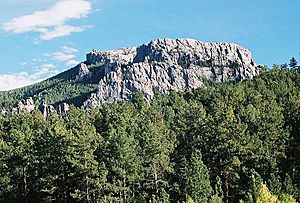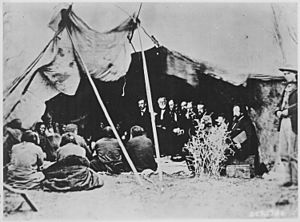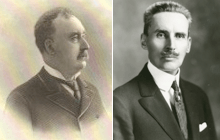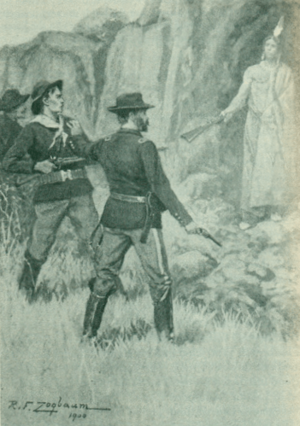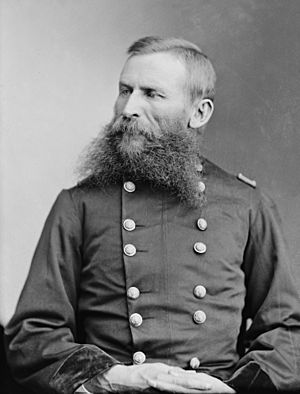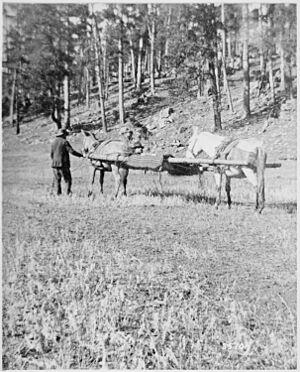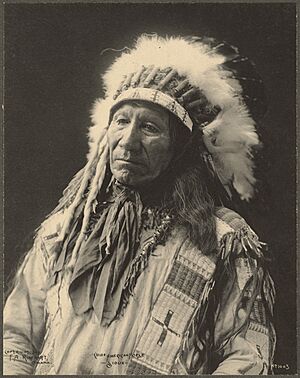American Horse (elder) facts for kids
American Horse (whose Lakota name was Wašíčuŋ Tȟašúŋke) was a respected Oglala Lakota warrior chief. He was born around 1830 and died on September 9, 1876. American Horse was known for his courage and honor. He was a key leader who worked with Crazy Horse during Red Cloud's War (1866–1868). He also fought in the Battle of the Little Bighorn during the Great Sioux War of 1876–1877.
American Horse was the son of Old Chief Smoke. His father was an important Oglala Lakota head chief. Old Chief Smoke was also one of the last great Shirt Wearers. This was a very respected warrior group among the Lakota. American Horse signed the Fort Laramie Treaty of 1868. His brothers, Chief Red Cloud and Chief Blue Horse, also signed it. After the treaty, American Horse was chosen as a "Shirt Wearer" (war leader). Other leaders chosen were Crazy Horse, Young Man Afraid of His Horses, and Man That Owns a Sword.
On September 9, 1876, American Horse was badly wounded. This happened during the Battle of Slim Buttes. He was fighting to protect his family and defend the sacred Black Hills (Paha Sapa) from white settlers.
Contents
The Smoke Family Leaders
Chief American Horse was a son of Old Chief Smoke. Old Chief Smoke was a main chief of the Oglala Lakota. He was also one of the last great Shirt Wearers. This was a very important warrior society. The Smoke family was one of the most famous Lakota families in the 1700s and 1800s.
Old Chief Smoke understood the power of the white settlers. He knew they had huge numbers and that war might not work. He believed it was important to learn about their customs. Old Chief Smoke had five wives and many children. His sons continued the Smoke family's leadership in Oglala Lakota culture. This continued into the early 1900s.
Old Chief Smoke's children included Spotted Horse Woman, Chief Big Mouth, Chief Blue Horse, Chief Red Cloud, Chief American Horse, Chief Bull Bear III, Chief Solomon Smoke II, Chief No Neck, and Woman Dress.
The Fort Laramie Treaty of 1868
Chief American Horse was a main war chief. He fought with Crazy Horse and Red Cloud during Red Cloud's War (1866-1868). American Horse signed the Fort Laramie Treaty of 1868. His brothers, Chief Red Cloud and Chief Blue Horse, also signed it.
This treaty was an agreement between the United States and the Lakota Nation. It promised the Lakota ownership of the Black Hills ("Paha Sapa"). It also gave them land and hunting rights in South Dakota, Wyoming, and Montana. The Powder River Country was supposed to be closed to all white people. This treaty ended Red Cloud's War.
About a month after the treaty, four "Shirt Wearers" (war leaders) were chosen. They were Crazy Horse, American Horse, Young-Man-Afraid-of-His-Horses, and Man That Owns a Sword.
General Crook's March
General George Crook led a difficult journey known as the "Horsemeat March". This march began after the U.S. Army learned about the defeat of George Armstrong Custer at the Battle of the Little Bighorn in June 1876. The American public was very upset and wanted the Sioux to be punished.
On August 26, 1876, General Crook and his soldiers left the Powder River. They headed east to find the Native American groups. Crook wanted to show that the U.S. Army would always follow its enemies. He wanted to teach the Native Americans a lesson. Many newspaper reporters traveled with General Crook. They sent news of the campaign back to their newspapers.
The Battle of Slim Buttes
The Battle of Slim Buttes happened on September 9 and 10, 1876. It was fought between the U.S. Army and the Sioux. This battle was the first U.S. Army victory after Custer's defeat at the Battle of the Little Bighorn.
General George R. Crook led his soldiers on the "Horsemeat March". They destroyed Chief American Horse's village at Slim Buttes. They also fought off a counter-attack by Crazy Horse. This battle was one of several attacks that eventually broke the Sioux's resistance. It forced them onto reservations and led to them losing the Black Hills.
The Village at Slim Buttes
After the Battle of the Little Bighorn, Lakota leaders went their separate ways. Many were trying to return to their reservations. On September 9, 1876, Chief American Horse's camp was attacked. His camp had 37 lodges and about 260 people. Around 30 to 40 of them were warriors. General George Crook's forces attacked and destroyed the village.
American Horse's camp was very rich. It was the season when wild plums were ripe. The lodges were full of furs, meat, and other supplies. Crook's soldiers destroyed much of the food. They also took hundreds of ponies, weapons, and blankets.
Soldiers found items from the Battle of Little Bighorn in the village. This included a flag (guidon) from the 7th Cavalry Regiment. It was attached to Chief American Horse's lodge. They also found bloody gloves belonging to Captain Myles Keogh, who had been killed. One lodge had thirty saddles and equipment. Soldiers also found money, jewelry, and government-issued guns.
American Horse's Brave Stand
On September 9, 1876, Captain Anson Mills and 150 soldiers attacked Chief American Horse's village at dawn. As the cavalry charged, Chief American Horse, his family, and about three warriors and twenty-five women and children hid. They went into a deep, dry ditch (ravine) that ran through the village.
This gully was nearly 20 feet deep and went back into a hillside. Trees and bushes hid the inside. Soldiers found out about the ravine when Private John Wenzel was shot and killed. He was the first army death at Slim Buttes. Other soldiers were wounded trying to get the Native Americans out.
Scouts who spoke Lakota tried to get them to surrender. But the Sioux refused. They yelled that more Sioux camps were nearby. They believed warriors would soon come to free them. Chief American Horse built a dirt wall in front of the cave. He prepared for a strong defense.
General Crook at the Ravine
On September 9, 1876, General Crook's main group arrived at Slim Buttes. They had marched twenty miles in about four and a half hours. Crook set up his headquarters and a hospital in one of the Indian lodges. He looked at the camp and the captured items. There were thirty-seven lodges. They found a three-year-old girl, but no bodies. Over 5,000 pounds of dried meat was found. This was a great help for the hungry soldiers.
Crook then focused on Chief American Horse and his family in the ravine. The soldiers fired many shots into the ravine. The cries of women and children were heard. General Crook ordered his men to stop firing. He did not know women and children were inside.
Scouts were ordered to offer safety to the women and children. They accepted. Crook himself helped a tall woman with an infant out of the ravine. Eleven other women and six babies also came out. But the remaining warriors refused to surrender. They started fighting again.
A Fierce Fight
Chief American Horse refused to leave. He stayed in the cave with three warriors, five women, and an infant. General Crook ordered his soldiers to fire heavily into the ravine. An estimated 3,000 bullets were fired at the warriors.
One reporter, John F. Finerty, wrote that the troops fired a "rain of hell." But the warriors fought with great courage for almost two hours. Another reporter, Robert Edmund Strahorn, described the terrible scene. He heard yelling, gunshots, crying children, and barking dogs. He saw the dead in the ditch and heard the screams of the wounded.
American Horse Surrenders
When the fighting calmed, scouts asked American Horse to surrender again. They told him he and his warriors would be safe. After thinking for a few minutes, Chief American Horse appeared. He was a strong-looking man. He held out the butt of his rifle, showing he would surrender.
He had been shot in the stomach and was holding his insides. He said he would surrender if the lives of his warriors were spared. Two of the women were also wounded. Eleven people had been killed in the hole.
General Crook took the rifle. He asked the scout to ask American Horse's name. The chief replied, "American Horse." Some soldiers wanted to kill him because they had lost friends. But Crook said, "Two or three Sioux, more or less, can make no difference. I can yet use them to good advantage." He promised American Horse and his men would not be harmed.
American Horse then called out to his two remaining followers. They came out of the gully. A woman, perhaps his wife, tied her shawl around his wound. The brave chief, without complaining, walked slowly to a campfire and sat down with the women and children.
Crazy Horse Attacks
Crazy Horse tried to rescue American Horse and his family. Native Americans who escaped the early morning attack told Crazy Horse and Sitting Bull what happened. Crazy Horse quickly gathered 600-800 warriors. They rode about ten miles to rescue Chief American Horse and get back supplies.
During the afternoon, Chief American Horse told General Crook that Crazy Horse was nearby. He warned that they would be attacked before nightfall. Crook prepared his forces. He hid most of his soldiers in the ravine. He left only a few visible to trick Crazy Horse.
As a grave was being dug for a soldier, shots were heard from the hills. Crook immediately ordered the village to be burned. Crazy Horse was surprised to find Crook's main army of over 2,000 soldiers. His warriors charged but were met with heavy fire. They quickly retreated. The battle ended as darkness fell.
Battle Losses
The U.S. Army had few losses. Three soldiers were killed and 27 were wounded. The Native American warriors usually fired from far away, so there were not many casualties. Those who died were Private John Wenzel, Private Edward Kennedy, and Scout Charles "Buffalo Chips" White. Private Kennedy and Chief American Horse died that evening.
Reports of Native American losses varied. Many bodies were carried away. At least 10 Sioux were confirmed dead, and many more were wounded. About 30 Sioux were in the ravine when the fight started. 20 women and children surrendered. Ten people stayed in the ravine during the heavy firing. Five of them were killed: Iron Shield, three women, one baby, and Chief American Horse. The rest were taken prisoner.
Death of American Horse
Two army doctors examined Chief American Horse. They tried to close his stomach wound, but they could not save him. The doctors told him he would die. Chief American Horse lived until 6:00 a.m. He told them that the tribes were scattering and losing hope in the war. He seemed happy that his wives and children were safe.
Dr. Valentine McGillycuddy, who cared for the dying chief, said he was cheerful. He showed great love for his wives and children. American Horse's family was allowed to stay on the battlefield after his death. They later rejoined their own people. General Crook was kind to them. He made them feel safe and at home.
Two Chiefs Named American Horse
There were two important Oglala Lakota chiefs named American Horse in American history. Historian George E. Hyde called them "Chief American Horse the Elder" and "Chief American Horse the Younger."
Chief American Horse the Elder was the son of Old Chief Smoke. He was also the cousin of Red Cloud.
Chief American Horse the Younger (1840 – December 16, 1908) was the son of Sitting Bear. He was also the son-in-law of Red Cloud. American Horse the Younger was an Oglala Lakota chief, leader, teacher, and historian. He was a U.S. Army Indian Scout. He worked to build good relationships with white people and supported education for his people.
American Horse the Younger did not agree with Crazy Horse during the Great Sioux War of 1876-1877. He also opposed the Ghost Dance Movement of 1890. He traveled to Washington as a Lakota representative. He was one of the first Native Americans to join Buffalo Bill's Wild West show. He also supported the Carlisle Indian Industrial School. He was known for being a wise leader and a good speaker.
American Horse the Younger became important during the Great Sioux War. After news of Chief American Horse the Elder's death, another chief named Manishnee took the name "American Horse." American Horse the Younger was not related to American Horse the Elder. He was from a different Oglala group that opposed the Smoke family.
Because of this, some historians have mixed up the stories of the two chiefs. Like his friend Crazy Horse, there are no known photographs or drawings of Chief American Horse the Elder.



